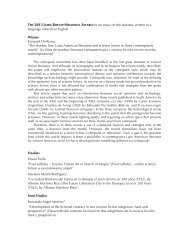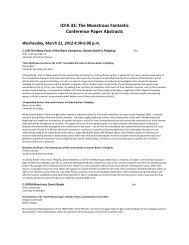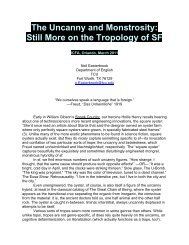takes a long time to evolve into the form found in <strong>The</strong> Silmarillion, and being able to examine this evolution step-by-step and in detail is amongthe great benefits of the History of Middle-earth. One of the changes evident is the evolution from the fanciful to the moral. It is not surprisingthat Tolkien eliminates such strange ideas as the purifying fire, Fôs’Almir, which cleanses Túrin Turambar and his sister Nienor of theirincestuous sin, and as the deification of the two mortals since Tolkien also deletes other astonishing ideas found in early texts. In Túrin’s tale,as with the Valaquenta, Tolkien seems to minimize the mythological, removing the pagan and fanciful. Even Túrin’s victory against Morgoth inthe Last Battle, by which “the children of Húrin and all Men [will] be avenged” (Lost Road 1987, 333), disappears from the publishedSilmarillion—along with the entire prophecy of Mandos—and there is no vengeance for Húrin’s family or mankind as a whole. <strong>The</strong> absence ofthese elements seems to increase the darkness of the tale and is consistent with Tolkien's statement: “I do not expect ‘history’ to be anythingbut a ‘long defeat’—though it contains . . . some samples or glimpses of final victory” (Letters 1981, 255). Additionally, these changes seem tounderscore the pervasiveness of evil, which Tolkien clearly demonstrates is woven into the very fabric of the created world since, as is told inthe Ainulindalë, Melkor/Morgoth participated in creation. No tale of Middle-earth is as dark as that of Túrin Turambar and his family, a talefrom which, in its final form, all glimmer of hope has been extinguished.*******Friday, March 23, 2012 10:30 a.m.-12:00 p.m.66. (SF) New Wave Science Fiction PineChair: Jennifer CoxFlorida Atlantic UniversityLife at the Top: Residential Segmentation and Class Division in Ballard’s High Rise and Silverberg’s <strong>The</strong> World InsideJeff HicksUC RiversideAs SF scholar Rob Latham has suggested, by the end of the 1960s the utopian promise suggested in Le Corbusier's 1930s architectural project the "VilleRadieuse" had begun to come under heavy criticism by SF's New Wave authors. <strong>The</strong> idea that centralized living and work spaces could create a classless,tightly-knit community seemed out of touch with the urban realities of the 60s and 70s. Specifically, the image of the tall, free-standing apartmentcomplex had become less associated with a community of equals than with the separation of a specific class of residents from the outside world. My paperaims to show the connection between the isolated, self-contained living spaces depicted in J.G. Ballard's High-Rise (1975) and Robert Silverberg's <strong>The</strong>World Inside (1971), and the residential segmentation and class segregation found in the urban realities of the late 1960s to mid-1970s.Impure Children and the Mothers That Keep <strong>The</strong>m: Nathaniel Hawthorne’s <strong>The</strong> Scarlet Letter and Judith Merril’s “That Only a Mother”Connor BoyleFlorida Atlantic UniversityMy paper offers a close reading of Judith Merril’s “That Only a Mother” as an atomic age Scarlet Letter tale, where the Puritan desire for moralpurity is replaced with post World War II America’s desire for genetic purity. Both Nathaniel Hawthorne’s <strong>The</strong> Scarlet Letter and Judith Merril’s“That Only a Mother” acknowledge that the “ideal mother” is a social construction, and that it is often the real love of a mother that preventsher from achieving this ideal. In Hawthorne’s 17 th -century New England, the village elders offer to adopt Pearl in order to properly socialize herand save the young girl’s soul. In Merril’s scientific America, the antidote for impurity is much more severe. My comparison will demonstratehow expectations placed on the “good citizen” often conflict with mothers’ rights in both religious and scientific societies. <strong>The</strong> characterizationsof the “protector” mother and the “socially minded” father in American fiction will also be explored.Before Stand on Zanzibar: John Brunner's Early FictionJad SmithEastern Illinois UniversityEditor Donald A. Wollheim regarded Brunner's early fiction as key to understanding his approach and once expressed regret that, for whateverreason, it tended to pass beneath critical notice (qtd. in De Bolt 19). Brunner himself frequently discussed <strong>The</strong> Squares of the City and <strong>The</strong>Whole Man as conscious experiments in craft conducted during his early career, and also once described his Ace novels as "dry-runs for thelater and more substantial books," adding "I set about this quite deliberately" (12). Nonetheless, Stand on Zanzibar is often viewed as alightning-strike moment without precedent in his early fiction. Through reconsideration of stories and novels such as “Fair” and <strong>The</strong> 100 thMillenium, and attention to Brunner’s own published comments about the craft in various prozines and fanzines, my paper examines the longgestatingapproach that led to Stand on Zanzibar and other notable fiction of Brunner’s mid-career.
67. (SF) Imperial and Postcolonial Imaginings in Science Fiction OakChair: Catherine SiemannCooper Union<strong>The</strong> Windigo in SF Contact NarrativeGrace L. DillonPortland State UniversityFrom Stephen King’s novel Pet Sematary (1984) to Eden Robinson’s “Dogs in Winter” (1999); from Antonia Bird’s film Ravenous (1999) to GrantHarvey’s Ginger Snaps Back: <strong>The</strong> Beginning (2004) and Larry Fessenden’s <strong>The</strong> Last Winter (2006), Windigo has become a familiar horror trope inboth literature and cinema. However, little has been written about its presence in sf, where combined interests in (post)colonial theory andpost-apocalyptic settings are incorporating Windigo as a metaphor of imperialism and conquest. Stephen Graham Jones’ <strong>The</strong> Fast Red Road: APlainsong (2000) and All the Beautiful Sinners (2003), Margaret Atwood’s Oryx and Crake (2005), Joss Whedon’s Firefly (2002), and other sfofferings use Windigo allegorically to examine the sociopolitical tensions of contact between Euro-western imperialism and Indigenous culture.A metaphor of “colonialism as cannibalism,” the Windigo trope can alternatively represent Euro-Western consumption of Indigenous peoples,lands, and resources or judgment and justice, or revenge, upon colonizers for their greed and brutality. Characters suffering possession by theWindigo might represent either the colonizer or the colonized, as both the role of imperialist conqueror and of victim reflect states of excessand imbalance. This metaphor is consistent with the Algonquian identification of the Windigo as the personification of excess, greed, andgluttony (Johnston, Ojibway Heritage 66).<strong>The</strong> Technology of Consent: American Technomilitary Fantasies in the 1980sChad AndrewsTrent UniversityIn the 1980s a group of American science fiction authors became enormously influential in the political sphere. Acting as leading members ofthe Citizens’ Advisory Council on National Space Policy, these authors (Jerry Pournelle, Larry Niven, Poul Anderson, Greg Bear, Gregory Benford,Dean Ing, Steven Barnes, and Jim Baen) conceptualized the Strategic Defense Initiative (SDI) for Ronald Reagan, advised his administration onforeign policy matters, and promoted the militarization of space as a means to end Cold War détente. While this paper recognizes their directand active engagement with the politics of the time, its primary focus is instead on the fiction--broadly termed ‘military science fiction’--theyproduced during the decade. I argue that a number of widely read texts written by the Advisory Council authors contributed to a kind ofconsensus culture during the 1980s, a hegemonic discourse that in turn founded itself on a particular conception of technology. <strong>The</strong> centraltenet of these texts (and of the general discursive trajectory they participated in) is that technology is subservient to other spheres of humaninterest and involvement--that we in other words have a firm grasp on technology. Like any tool, it serves us when necessary, and is ultimatelyguided by the traditions and values established in the cultural and political spheres.Science Fiction and PostcolonialismDavid M. HigginsIndiana UniversityPostcolonial literatures are often understood to be fictions written by authors from locations around the world that once suffered colonialoccupation by Western powers; such literatures respond in various ways to the complex dynamics of continuing imperial legacies in theaftermath of decolonization. In this regard, science fiction would not often be viewed as a postcolonial genre in the most traditional sense;aside from a few collections such as Nalo Hopkinson’s So Long Been Dreaming: Postcolonial Science Fiction & Fantasy (2004) – which gatherstogether a diverse group of authors who write short stories with postcolonial concerns – few science fictions showcase the firsthand voices ofauthors who Gayatri Spivak would refer to as “subaltern” subjects whose perspectives have historically been neglected and devalued inmainstream Western culture. Science fiction as a whole, however, offers insightful critical perspectives regarding colonialism and imperialismduring the postcolonial moment. This presentation traces critical intersections between science fiction and postcolonial thought, and it arguesthat there are multiple ways to articulate the relationships between SF and postcolonial thinking.68. (CYA) How the Reader Uses the Monster MapleChair: Amanda FirestoneUniversity of South FloridaFeral, Growling, Hungry: Young Readers and the Sensuous World of MonstersDawn RouseMcGill UniversityA fascination with monsters often begins in early childhood: Young readers return to favorite texts repeatedly, and grow savage skins in theirplay-- growling, stomping and snarling. As beasts, children can fully explore the world through sensual experiences. While psychologists havetraditionally read this play as an exploration of power and powerlessness in childhood, we investigate how 'being monsters' allows children tosafely embody the bestial. And, because one continues to feel freakish as they transform in young adulthood, we extend the conversation toconsider how adolescent readers may experience the monstrous through the literature produced for them. In this paper, we draw on Merleau-Ponty’s conception of phenomenology, theories of Embodied Education and the criticism of young people’s literature and culture to ‘cage’ theconversation. Additionally, we examine how young readers explore and conceptualize monsters through their real world experience of story
- Page 4 and 5: 5. (F) Wondrous Bodies of the Gende
- Page 6 and 7: Fantastic Suicide: Reading the Unca
- Page 8: Viral Posthumanism: Boundaries and
- Page 11 and 12: The Concept of Soul Divisibility in
- Page 13 and 14: Thursday, March 22, 2012 10:30 a.m.
- Page 15 and 16: 21. (CYA) Terrifying Futures: Post-
- Page 17 and 18: 23. (FTV/H) Now I’m Feelin’ Zom
- Page 19 and 20: Fight Club: Amalgam of the Horrific
- Page 21 and 22: Taking the Monsters out of the Clos
- Page 23 and 24: Kaspar J. SaxenaIndependent Scholar
- Page 25 and 26: 44. (CYA) The Monstrosity of Teenag
- Page 27 and 28: 46. (FTV/SF) Monstrous Spin-offs: T
- Page 29 and 30: 49. (F) Aspects of Miéville Captiv
- Page 31 and 32: 53. (SF) War and Crisis in 1940s an
- Page 33 and 34: Abuse of Power: An Evolutionary Res
- Page 35 and 36: Disappearing Natives: The Colonized
- Page 37 and 38: 60. (H/IF) Ancient and Medieval Mon
- Page 39: 62. (F) The Works of Tolkien Captiv
- Page 43 and 44: Beheading the Gorgon: Beautifying C
- Page 45 and 46: 71. (VPA) Monstrous Music MagnoliaC
- Page 47 and 48: 73. (F/IF) Portraying New Worlds Ca
- Page 49 and 50: Friday, March 23, 2012 2:45-3:45 pm
- Page 51 and 52: 81. (FTV) Those Damn Dirty Apes! Cy
- Page 53 and 54: Friday, March 23, 2012 4:00-5:30 pm
- Page 55 and 56: 92. (F) Leaving the Demonized Other
- Page 57 and 58: 94. (FTV/CYA) Monstrosity and Devia
- Page 59 and 60: of cannibalism, ghostly seduction i
- Page 61 and 62: Saturday March 24, 2012 8:30-10:00
- Page 63 and 64: 104. (CYA) Classic Monsters, Reinte
- Page 65 and 66: 107. (VPA) Monstrous Gaming Bodies
- Page 67 and 68: who challenge the order that the Br
- Page 69 and 70: Reading Between the Times: A Critic
- Page 71 and 72: 117. (FTV) Monsters and Superheroes
- Page 73 and 74: 119. (IF/H/PCS) International Mash-
- Page 75 and 76: Focusing on Stoker's Dracula as one
- Page 77 and 78: Florida Atlantic UniversitySheri S.
- Page 79 and 80: Simmons CollegeIn the spate of rece
- Page 81 and 82: Independent ScholarKing’s story
- Page 83 and 84: modernity opens up for every indivi
- Page 85 and 86: Saturday March 24, 2012 4:00-5:30 p
- Page 87 and 88: 141. (FTV) Monstrous Masculinity Cy
- Page 89 and 90: ultimately make peace with her mons
- Page 91 and 92:
where the almost-human sentient zom





